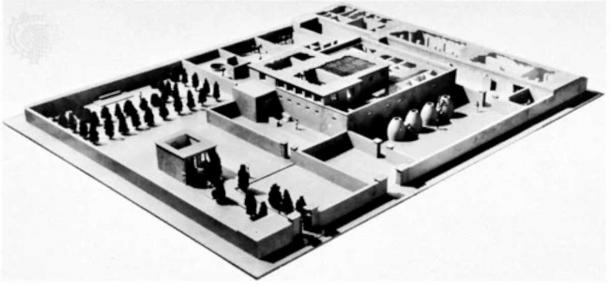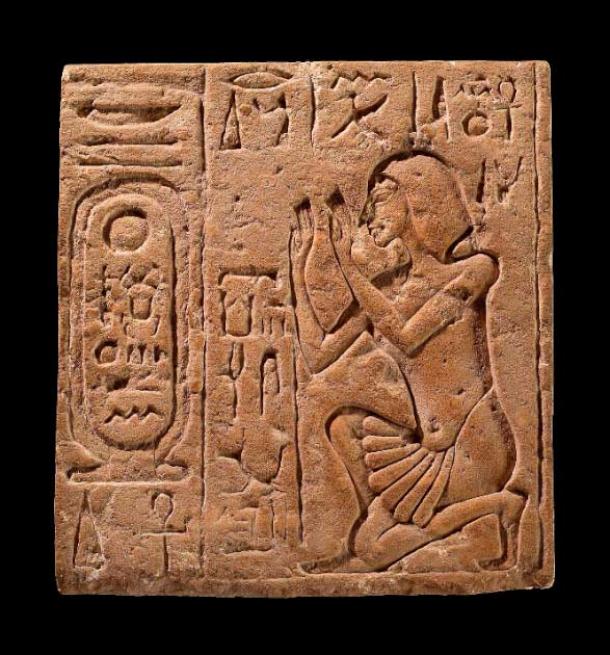
Walk (to Work) Like an Egyptian: Nakhtpaaten, the First Commuter
In the modern world, traveling to and from work seems to be a relatively easy thing to do. Whether by bus, car, or metro, getting to your workplace is rarely a challenge. But what about the ancient world? In those powerful civilizations that are lost to history, there were certainly important jobs to be completed, and daily tasks that required plenty of time to fulfill. Today, we are trying to understand the way ancient peoples journeyed to their jobs - by studying the example of Nakhtpaaten, a high-ranking ancient Egyptian official who was likely history’s very first commuter.
Was Nakhtpaaten the First Commuter in Human History?
When you think of ancient Egypt, it is hard to think of people having regular jobs with 9-to-5 shifts, and the usual duties. However, such a vast and powerful civilization was full of complexity, and had to run like a well-oiled machine. For that, it needed a highly developed network of officials, bureaucrats, accountants, and notaries, all of whom had to be at their jobs - every day. But in a time when there were no cars, buses, trains, or even bicycles, it must have been challenging to travel to your work, especially if you lived far away from it.
The story of Nakhtpaaten is telling us exactly this - in ancient Egypt, it was usually walking that got you to where you needed to go. Nakhtpaaten lived during the reign of a very important and controversial pharaoh: Akhenaten. This ruler, who reigned from 1353 to 1336 BC in the 18th dynasty, is remembered in history for his infamous attempts at reforming the very old ancient Egyptian religion from the ground up. He introduced the worship of the sun, known to then as Aten, and even constructed an entirely new capital for himself: the city of Akhetaten, now known as Amarna.
- Talatat Blocks and Akhenaten’s Failed Architectural Revolution
- Pharaoh Akhenaten: An Alternative View of the Heretic King

It’s tough to be the pharaoh! Akhenaten had supreme power, but was very controversial. A colossal statue of Akhenaten from his Aten Temple at Karnak, now on display at the Egyptian Museum of Cairo. (Gerard Ducher / CC BY SA 2.5)
After Akhenaten’s controversial rule came to an end, the embittered Egyptians tried very hard to erase every trace of him from existence. His relics, monuments, temples, and cities were all razed to the ground, and ancient Egypt returned to its old ways. But modern archaeology allows us to pierce through the layers of dirt, soil, and rubble, uncovering the remnants of Akhenaten's enigmatic and short-lived reign.
It was during the excavations of the city of Akhetaten that researchers came upon the remains of a special house. The home, situated in the far south of the town, was a lavishly built mansion, indicating that the owner was a person of power and wealth. The mansion had all the luxuries of the time: bedrooms, lavatories, a reception hall, a set of offices, hallways, and all the other important living spaces. In short, it was one of the grandest homes in Pharaoh Akhenaten’s new capital city.
- A Tough Commute: Long Hike to Work in the Valley of the Kings Caused Laborers to Suffer from Arthritis
- The Art of Amarna: Akhenaten and his life under the Sun
Uncovering the Life and Deeds of Vizier Nakhtpaaten
Following the discovery of this luxury estate, Leonard Woolley published detailed descriptions of it in 1922. By studying the mansion in detail, he allowed us to understand the complexity with which the ancient Egyptians built their homes, and told us that its owner was someone very important in Akhenaten’s regime. Upon entering, there is a downward flight of stairs, which leads to a series of small entry rooms. Beyond them lay a spacious and lavish receiving room, often described in sources as an ancient version of a loggia. This is usually a covered and lavish open space, with arches on its sides, where the host would receive his guests and thus display his wealth.
The power of modern archaeology has allowed researchers to paint a detailed picture of this ancient home. All the walls were whitewashed, with certain colors used to accentuate space and give decoration. In the loggia, the ceiling was deep blue, perhaps mimicking the open sky above.
After this space was the home’s central part: a large pillared hall, around 86 square feet (8 square meters) in size, acting as the home’s main reception area. Off to one side was a specially-built divan, a leisurely sitting area, made entirely out of brick. It was very long, stretching against the entire wall. The ceilings were very high in this reception area, giving the impression of grandeur and wealth.
Off to the sides and in the home’s rear were the private rooms. There was the owner’s bedroom, smaller rooms, and the lavatories. The bathroom was also large, with a raised platform upon which the bathing tub was placed. It had raised steps which allowed servants to pour hot water over those bathing. All this indicated wealth, power, and status.
Beyond the reception hall was yet another loggia, with large open windows to one side. We can safely say that it was a frequently used area, especially in the times when the sun would heat it directly through the open windows. And it was in this room that archaeologists uncovered the first traces of the house owner’s name. The walls of the loggia were inscribed with various scenes and inscriptions. One scene depicted Pharaoh Akhenaten, as he worshiped Aten, the main symbol of his new religion. It was a clear sign of the house owner’s unfaltering loyalty to the pharaoh. But in a small niche to the side, the owner reserved the place to mention himself also. The inscriptions here told us his name: Nakhtpaaten.

Model of an Amarna noble’s estate, like Nakhtpaaten’s luxury mansion (Brittanica / CC 4.0)
Akhenaten’s Loyal Servant Who Traveled Daily to his Job
History knows a little bit about Nakhtpaaten, and with the discovery of his home, the story of his life became even more complete. First, historians tackled his name, translating it to “Strong is the Aten”. This tells us that the man was perhaps born after Akhenaten came to rule, or changed his name in order to better display his loyalty. This is because his name contains “Aten”, the main object of worship in Akhenaten’s new religion.
We know that Nakhtpaaten held the office of a vizier. This was no small position. The vizier was the highest ranking official to serve the pharaoh, with many important duties and a strict code of behavior. Often, the vizier was appointed by the pharaoh himself, which was likely the case with Nakhtpaaten. Researchers think that Nakht, as he is commonly called, succeeded Vizier Ramose, and likely very early in Akhenaten’s reign. We know this from the frescoes in ex-vizier Ramose’s lavish tomb. In the funerary paintings, the new pharaoh only just got to the throne, and is mentioned with his original name - Amenhotep IV. Only in the fifth year of his reign did he adopt the name Akhenaten.
All this tells us that Nakhtpaaten was one of the powerful men loyal to the new and increasingly controversial pharaoh. But it was this loyalty that likely earned him the post of the new vizier, and in no time he became one of the most powerful men in ancient Egypt, after the pharaoh. By reaching this position, Nakht received a string of lofty titles and callings, which were inscribed in his home:
“Hereditary prince, count, seal-bearer, overseer of the city and vizier, overseer of the work projects in Akhet-Aten.”
So, we now know that history's very first commuter was a man of immense power. And yet he still had to walk every day in order to reach his workplace.

Limestone relief depicting the Overseer of Works, believed to be Nakhtpaaten, worshipping Akhenaten as the "living Aten". New Kingdom, Dynasty 18, reign of Akhenaten, 1353–1336 B.C. (MFA Boston / Public Domain)
Archaeologists were intrigued at first with the discovery of Nakht’s lavish mansion. It was one of the richest in the new city, but was situated in the far southern parts, very far from the city center. And Nakhtpaaten’s lofty position required him to be present at the royal palace every day, where he would advise the pharaoh and fulfill his duties. Researchers deduced that Nakhtpaaten had to commute every day, crossing the large city of Akhetaten in order to get to his job. Whether he walked, or was carried by servants, we can’t say for certain - but either way, it was an uncommon thing for a royal vizier to do.
Commuting through Akhetaten’s Rush Hour
There is no doubt that Nakhtpaaten was a man loyal to Akhenaten - to the core. Whether a simple opportunist, or a staunch believer in the pharaoh’s new religion, the new vizier was dubbed a true loyalist. It was a time when ancient Egypt was full of divisions, and the new regime was quite disliked by the general populace. It is likely that Nakhtpaaten earned a bit of enmity himself, especially after getting so immensely rich so quickly. Still, he was a prominent man, and is featured in a number of excavated frescoes and inscriptions.
In the tomb of Mahu, who was the police chief of the new capital Akhetaten, there is a fresco that depicts Nakhtpaaten as well. Mahu, proudly fulfilling his police duties, is shown meeting with the powerful Vizier Nakhtpaaten, bringing two accused trespassers to him. It is clear that this inclusion on the fresco was meant to make Mahu as important as possible, by depicting himself meeting with someone as powerful as Nakhtpaaten.
Alas, the fate of the first commuter in history remains unknown to us. In the necropolis of the city of Akhetaten, particularly in the southern tombs, there is a tomb that was supposed to house his remains. It is tomb number 12, reserved for Nakhtpaaten the Vizier. Alas, it was never finished. Only the front facade was finished, and the first room upon entry was begun. We can only speculate why the tomb was never finished, and where the remains of Nakht ended up.
It is possible that the vizier outlived his pharaoh and his reign. Akhenaten died after 17 years as pharaoh, and his deeds and decisions were quickly reversed. His successor, Tutankhamun, abandoned Akhetaten and the new religion, leaving the city to be forgotten and ruined. The reminders of Akhenaten were destroyed in acts of vengeance, his temples razed, and his capital largely dismantled.
It is possible that Nakhtpaaten was caught up in the chaos following the pharaoh’s death. His fate is unknown to us, but we can assume that he was a major target, being a staunch loyalist and a very wealthy man. He never had the chance to see his tomb finished, and his final resting place remains lost to time and history.

Bluff showing entrance to some of the southern tombs at Amarna, where Nakhtpaaten’s tomb was only begun. (Public Domain)
A Victim of Circumstance or a Diligent Commuter?
Modern research allows us to piece together the image of Akhetaten with striking accuracy. With archaeology and modern technology, historians know that the new capital was a busy, crowded, and sprawling city. The main promenades and the city center were rich and reserved for the nobles, while the snaking side streets were nothing more than slums, where the poor folk had their homes and shops. Akhetaten was a city of contrasts, where the rich and poor lived side by side, with mutual disdain.
And through all that squalor and grandeur, through the crowds and the busy folk, Vizier Nakhtpaaten commuted every day. The ancient Egyptians didn’t have a lot of mounts or transports, but it is possible that the vizier was carried to his workplace by a number of servants. Perhaps he chose the pragmatic way, and walked the distance surrounded by his retinue of bodyguards. Whichever way it was, Nakhtpaaten had to travel several kilometers every day, in order to fulfill his duties as a vizier. And that certainly makes him history’s first known commuter.
Top Image: Nakhtpaaten may have been the first commuter, crossing ancient Amarna to his daily job as royal vizier. Illustration of an imagined ancient Egyptian city. Source: KHBandak / Adobe Stock
References
Darnell, J. 2022. Egypt's Golden Couple: When Akhenaten and Nefertiti Were Gods on Earth. The History Press.
De La Bédoyère, G. 2023. Pharaohs of the Sun: The Rise and Fall of Tutankhamun's Dynasty. Simon and Schuster.
Dodson, A. 2014. Amarna Sunrise: Egypt from Golden Age to Age of Heresy. Oxford University Press.
Ede, C. September 14, 2021. Egyptian Fragment of a Statuette of a Vizier. Charles Ede. [Online] Available at: https://www.charlesede.com/blog/94/















